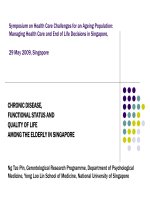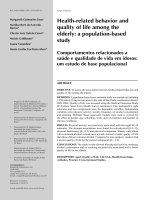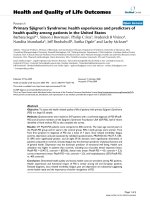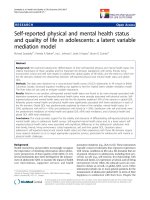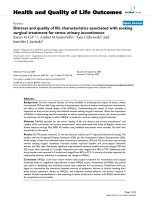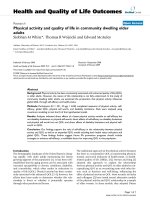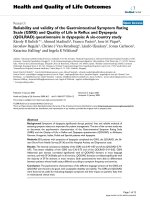Adverse life experiences and quality of life among senior citizens of bhutan
Bạn đang xem bản rút gọn của tài liệu. Xem và tải ngay bản đầy đủ của tài liệu tại đây (6.58 MB, 363 trang )
ADVERSE LIFE EXPERIENCES AND QUALITY OF LIFE
AMONG SENIOR CITIZENS
OF BHUTAN
NIDUP DORJI
ADVERSE LIFE EXPERIENCES AND QUALITY OF LIFE
AMONG SENIOR CITIZENS OF BHUTAN
Nidup Dorji
BSN, MPH
Submitted in fulfilment of the requirements for the degree of
Doctor of Philosophy
School of Public Health and Social Work
Faculty of Health
Queensland University of Technology
November, 2016
i
ABSTRACT
The world population is ageing at an unprecedented rate, which is faster now in the
developing countries than in the economically developed world. Asia accounts for
more than half of the global population. The number of Bhutanese older people
(aged > 60 years) is expected to increase from 4.7% in 2005 to 11.2% in 2045, at a
population growth rate of 1.8% per annum. Improved health, increased access to
education, and economic growth have contributed to longer life expectancy. The
steady growth of the older population presents many challenges to families,
communities, and societies, particularly for sustainability of health care, pensions
and social benefits, and the preservation of quality of life and wellbeing.
Older people have traditionally been held in high esteem for their wisdom, their
roles as heads of families, and their effective mediation in conflict resolution.
However, trends such as urbanisation and modernisation, which tend to change
family structures and cohesion, affect the support and care of older family
members. In Bhutan, many people have expressed concern about the survival of the
much - revered traditions of extended family systems. With more and more people
moving to urban areas in search of a better future, senior citizens are being left
behind in the rural communities, often to fend for themselves.
In Bhutan, there has been limited research into factors influencing quality of life
(QOL) and wellbeing among older people. Globally, however, research into
determinants of wellbeing among elders has a long history and the findings are very
complex. The present study provides a broad overview of that research, but the
particular focus here is on the effects of adverse experiences across the lifespan on
Adverse Life Experiences and Quality of Life among Senior Citizens of Bhutan
i
ii
quality of life of people aged over 60 years. Adverse childhood experiences (ACEs)
and stressful life events (SLEs), both distal and proximal during adulthood, are found
to have significant associations with physical and mental health of adults. In Bhutan,
the impact of adverse experiences on health, wellbeing and QOL has not been
explored among older people. In order to address this gap, this study applied a
sequential exploratory mixed-methods design to examine the relationships
between adverse experiences - during childhood, in early and middle adulthood,
and in the preceding year – and the QOL and wellbeing of Bhutanese older people.
The study commenced with an exploratory qualitative phase employing three focus
group discussions (FGDs) and 30 in-depth interviews (IDIs) with older people of
Bhutan. Survey interviews were completed with 337 older people living in four
geographical locations of Bhutan through face-to-face interviews by trained
interviewers. A survey instrument was carefully developed through the modification
of relevant international instruments as well as the information from the qualitative
phase. The reliability and validity of the instrument were enhanced through
systematic procedures. Cultural appropriateness was considered in the design and
implementation of qualitative and quantitative phases.
The IDIs and FGDs provided information about education, employment, wealth,
property, and health conditions as the frequently reported factors influencing QOL.
Family-related factors, spirituality and meeting basic minimum needs in life also
played important roles for QOL among elderly people. Enforced child labour was the
most frequently reported early adversity, while death of children was the most
ii Adverse Life Experiences and Quality of Life among Senior Citizens of Bhutan
iii
serious life event during adult years. The findings from the first phase were valuable
and suggested important variables for the survey instrument development.
The quantitative survey confirmed that forced labour contribution followed by
having to assume an adult role while still a child were the most prevalent early
adversities. The death of parents or children, a period of time when the person was
not able to feed and clothe children due to severe poverty, loss of crops or animals
impacting livelihood, damage due to natural calamities, and the experience of
children leaving the household were common SLEs. In terms of health and
wellbeing, frequent back pain, visual impairment, disease of the joints, fatigue,
depression, insomnia, memory decline, high blood pressure and diseases of the
lungs were most commonly reported. Various serious health problems, such as
disease of the lungs, high blood pressure, diabetes, gout, visual impairment,
depression, insomnia, and memory decline were significantly associated with ACEs.
A wide range of demographic characteristics, physical and mental health conditions,
ACEs, SLEs, and social connectedness were significantly associated with reduced
quality of life and wellbeing. However, age and marital status were not found to be
related to QOL.
After controlling for socio-demographic characteristics, multiple linear regression
found that cumulative health problems and psychological distress, spirituality and
social connectedness were significant and independent correlates of overall QOL.
The cumulative health problems and psychological distress also predicted wellbeing
and health-related quality of life (HRQOL).
Adverse Life Experiences and Quality of Life among Senior Citizens of Bhutan
iii
iv
This is the first study to investigate QOL and its determinants among older people in
Bhutan applying both qualitative and quantitative methods. The study contributes
insights into previously un-researched issues affecting older people in Bhutan and
may assist development of socially and culturally appropriate interventions to
promote health, wellbeing, and QOL of older people. Hopefully, the work will be
used to inform policy makers about the probable effects of adverse life experiences,
especially the adverse childhood experiences that appear to have impact into late
adulthood.
iv Adverse Life Experiences and Quality of Life among Senior Citizens of Bhutan
v
KEYWORDS
Bhutan, quality of life, health related quality of life, wellbeing, aged, older
people/senior citizens, adverse childhood experiences, stressful life events,
spirituality, psychological distress, prevalence
Adverse Life Experiences and Quality of Life among Senior Citizens of Bhutan
v
vi
TABLE OF CONTENTS
Abstract ......................................................................................................................... i
Keywords ...................................................................................................................... v
Table of Contents ........................................................................................................ vi
List of Figures................................................................................................................ x
List of Tables ................................................................................................................ xi
List of Abbreviations ...................................................................................................xiii
Statement of Original Authorship ..............................................................................xiv
Acknowledgments ...................................................................................................... xv
Dedication ................................................................................................................ xviii
CHAPTER 1: INTRODUCTION ................................................................................ 1
1.1 Background of the Study ........................................................................................ 1
1.2 Background of the Kingdom of Bhutan .................................................................. 5
1.3 Healthcare System in Bhutan ................................................................................. 8
1.4 Study Locations and Sample .................................................................................. 9
1.5 Significance of the Study ...................................................................................... 10
1.6 Structure of the Thesis ......................................................................................... 11
CHAPTER 2: LITERATURE REVIEW ....................................................................... 13
2.1 Search Strategy..................................................................................................... 13
2.2 Global Ageing Scenario......................................................................................... 14
2.3 Definitions of Quality of Life and Health-Related Quality of Life......................... 16
2.4 Wellbeing.............................................................................................................. 19
2.5 Determinants of Quality of Life and Wellbeing.................................................... 20
2.6 Influence of Health Status on Quality of Life and Wellbeing ............................... 27
2.6.1 Physical Aspects of Health, QOL and Wellbeing ....................................... 27
2.6.2 Psychological Health, Quality of Life and Wellbeing ................................. 28
2.7 Physical Activity and Leisure ................................................................................ 29
2.8 Sexual Activity and Quality of Life ........................................................................ 31
2.9 Culture and Respect for the Older Adults ............................................................ 32
2.10 Social Relationships, Social Connectedness, and Social Activities ..................... 34
2.11 Effects of Religiosity/Spirituality on Quality of Life and Wellbeing ................... 38
vi Adverse Life Experiences and Quality of Life among Senior Citizens of Bhutan
vii
2.12 Stressful Life Events and their Impacts on Quality of Life and Wellbeing ......... 41
2.13 Adverse Childhood Experiences and their Influence on Quality of Life and
Wellbeing ............................................................................................................ 45
2.14 Adverse Life Experiences and Resilience ........................................................... 51
2.15 Drawing the Determinants of QOL and Wellbeing Together: Research
Questions, Aims and Objectives ......................................................................... 53
2.16 Aims and Objectives of the Study ...................................................................... 56
CHAPTER 3: RESEARCH DESIGN .......................................................................... 57
3.1 Design of the Study .............................................................................................. 57
3.1.1 Phase 1: Literature Review ....................................................................... 57
3.1.2 Phase 2: Exploratory Qualitative Interviews ............................................. 57
3.1.3 Phase 3: Development, and Modification of the Survey Instrument ....... 58
3.2 Study Sites ............................................................................................................ 60
3.3 Study Population, Sample Size, and Data Collection Methods ............................ 60
3.3.1 Phase 2: Exploratory Qualitative Research ............................................... 60
3.3.2 Phase 3: Quantitative Cross-Sectional Survey .......................................... 65
3.4 Development of the Survey Instrument .............................................................. 67
3.4.1 Information from the Qualitative Study ................................................... 68
3.4.2 Pilot Study for Quantitative Survey .......................................................... 68
3.5 Survey Variables ................................................................................................... 69
3.5.1 Details of the Dependent Variables .......................................................... 69
3.5.2 Details of the Main Independent Variables .............................................. 74
3.6 Quality of the Survey Instrument......................................................................... 80
3.6.1 Internal Consistency .................................................................................. 80
3.7 Data Analysis and Management .......................................................................... 81
3.7.1 Quantitative Survey Data Analysis ............................................................ 81
3.8 Ethics Considerations ........................................................................................... 85
CHAPTER 4: QUALITATIVE FINDINGS .................................................................. 87
4.1 Demographic Characteristics of the Participants ................................................ 87
4.2 Qualitative Data Analysis ..................................................................................... 88
4.2.1 Process of Data Analysis............................................................................ 88
4.2.2 Content Analysis........................................................................................ 89
4.3 Findings from the In-Depth Interviews ................................................................ 93
4.4 Findings from the Focus Group Discussions ...................................................... 122
Adverse Life Experiences and Quality of Life among Senior Citizens of Bhutan
vii
viii
4.5 Summary of Findings .......................................................................................... 138
4.6 Practical Contribution of the Qualitative Interviews to Instrument Development
and Survey Procedure ....................................................................................... 139
4.7 Conceptual Framework ...................................................................................... 140
CHAPTER 5: DESCRIPTIVE ANALYSIS OF THE SURVEY DATA ............................... 142
5.1 Characteristics of the Study Sample................................................................... 143
5.2 Prevalence of Adverse Childhood Experiences .................................................. 145
5.3 Prevalence of Stressful Life Events..................................................................... 148
5.4 General health and Lifestyle .............................................................................. 153
5.5 Psychological Distress......................................................................................... 157
5.6 Spirituality .......................................................................................................... 158
5.7 Social Connectedness ......................................................................................... 158
5.8 Wellbeing Among Elderly People in Bhutan ...................................................... 158
5.9 Health-Related Quality of Life ............................................................................ 161
CHAPTER 6: BIVARIATE AND MULTIVARIATE ANALYSIS OF QUALITY OF LIFE AND
HEALTH-RELATED QUALITY OF LIFE .................................................................. 167
6.1 Relationship Between Demographic Characteristics, QOL, and HRQOL ........... 168
6.2 Relationship Between the General Health Conditions and Cumulative Health
Problems, QOL, and HRQOL .............................................................................. 173
6.3 Relationship Between Specific Health Problems, QOL, and HRQOL .................. 178
6.4 Adverse Childhood Experiences and Multiple Health Problems ....................... 179
6.5 Cumulative Adverse Childhood Experiences, QOL, and HRQOL ........................ 179
6.6 Relationship Between Stressful Life Events and Specific Health Problems ....... 183
6.7 Relationship Between Stressful Life Events, QOL, and HRQOL .......................... 185
6.8 Bivariate Correlations Between Psychological Distress, Spirituality, and Social
Connectedness with QOL, and HRQOL ............................................................. 187
6.9 Correlations Between QOL, QOL Domains, General Health Satisfaction, and
HRQOL ............................................................................................................... 188
6.10 Correlates of the Overall Quality of Life........................................................... 190
6.11 Correlates of Health-Related Quality of Life .................................................... 191
CHAPTER 7: BIVARIATE AND MULTIVARIATE ANALYSIS OF SURVEY DATA ON
WELLBEING ...................................................................................................... 195
7.1 Relationship Between Demographic Characteristics and Wellbeing ................. 195
7.2 Relationship Between the General Health Conditions and Cumulative Health
Problems and Wellbeing ................................................................................... 198
7.3 Relationship Between Specific Health Problems and Wellbeing ....................... 199
viii Adverse Life Experiences and Quality of Life among Senior Citizens of Bhutan
ix
7.4 Relationship Between “Bhutan-Specific” and Cumulative ACEs with Wellbeing
........................................................................................................................... 201
7.5 Relationship Between Stressful Life Events and Wellbeing ............................... 202
7.6 Bivariate Correlations Between Psychological Distress, Spirituality, and Social
Connectedness with Wellbeing ........................................................................ 203
7.7 Correlates of Wellbeing..................................................................................... 203
CHAPTER 8: DISCUSSION AND CONCLUSION......................................................208
8.1 Common health problems among older adults in Bhutan ................................ 211
8.2 Adverse Childhood Experiences ......................................................................... 212
8.3 Stressful Life Events ........................................................................................... 214
8.4 Resilience in the Face of Adversity .................................................................... 215
8.5 Spirituality/religiosity ......................................................................................... 216
8.6 Social Connectedness/Social Support and Respect for Older People ............... 218
8.7 Strengths of the Study........................................................................................ 220
8.8 Limitations of the Study ..................................................................................... 221
8.9 Suggestion for Further Research........................................................................ 224
8.10 Implications for Public Health Practice ............................................................ 226
8.11 Contribution to the body of knowledge .......................................................... 228
8.12 Reflections and Lessons Learned ..................................................................... 228
REFERENCES .....................................................................................................233
APPENDICES .....................................................................................................283
APPENDIX A: PARTICIPANT INFORMATION AND CONSENT FORM FOR IN-DEPTH
INTERVIEW ........................................................................................................ 284
APPENDIX B: PARTICIPANT INFORMATION AND CONSENT FORM FOR FGD .......... 287
APPENDIX C: PARTICIPANT INFORMATION IN BHUTANESE LANGUAGE ................. 290
APPENDIX D: GUIDELINES FOR IN-DEPTH INTERVIEW ............................................. 292
APPENDIX E: GUIDELINE FOR FOCUS GROUP DISCUSSION ..................................... 294
APPENDIX F: SURVEY QUESTIONNAIRE.................................................................... 295
APPENDIX G: QUT ETHICS APPROVAL ...................................................................... 311
APPENDIX H: RESEARCH ETHICS BOARD OF HEALTH (REBH) CLEARANCE .............. 313
APPENDIX I: APPROVAL LETTER FROM MINISTRY OF HOME AND CULTURE,
THIMPHU, BHUTAN........................................................................................... 315
APPENDIX J: PICTURES FROM THE STUDY SITES AND DATA COLLECTION .............. 317
APPENDIX K: CONTENT ANALYSIS ............................................................................ 321
APPENDIX L: SUPPORTING ANALYSIS ....................................................................... 328
Adverse Life Experiences and Quality of Life among Senior Citizens of Bhutan
ix
x
LIST OF FIGURES
Figure 1.1: Location of Bhutan in South Asia ........................................................... 10
Figure 3.1: Study Flow Diagram ............................................................................... 58
Figure 3.2: Location of the Study Sites ..................................................................... 61
Figure 4.1: Conceptual Framework ........................................................................ 141
x Adverse Life Experiences and Quality of Life among Senior Citizens of Bhutan
xi
LIST OF TABLES
Table 2.1: Example of output from literature search using PUBMED
database .................................................................................................. 15
Table 2.2: Theoretical and operational definitions of the variables ........................ 54
Table 3.1: WHOQOL-BREF Facets and Domains ...................................................... 71
Table 3.2: Social Readjustment Rating Scale (SRRS) ................................................ 78
Table 3.3: Internal consistency for multiple scales in the pilot study ...................... 81
Table 4.1: Demographic information of the IDI and FGD participants .................... 90
Table 5.1: Socio-demographic characteristics of the sample by gender ............... 144
Table 5.2: Prevalence of Adverse Childhood Experiences by gender ..................... 145
Table 5.3: Prevalence of “Bhutan-specific” ACEs by gender .................................. 147
Table 5.4: Multiple Adverse Childhood Experiences (ACEs) by gender .................. 148
Table 5.5: Prevalence of distal and proximal Stressful Life Events by gender ....... 150
Table 5.6: Cumulative Stressful Life Events (SLEs) by gender................................. 152
Table 5.7: General health conditions and health seeking behaviour by
gender .................................................................................................... 153
Table 5.8: Prevalence of common health morbidities by gender........................... 155
Table 5.9: Prevalence of the common medications used by gender ...................... 156
Table 5.10: Prevalence of total health problems by gender .................................. 156
Table 5.11: Prevalence of psychological distress by gender .................................. 157
Table 5.12: Prevalence of spirituality (item wise) by gender ................................. 159
Table 5.13: Prevalence of social connectedness (item wise) by gender ................ 160
Table 5.14: Prevalence of wellbeing (item wise) by gender ................................... 162
Table 5.15: Distribution of health-related quality of life by gender....................... 164
Table 5.16: Mean score of the facets and domains of QOL by gender .................. 165
Table 6.1: Bivariate association between socio-demographic characteristics
and QOL, and health-related quality of life ........................................... 171
Table 6.2: Bivariate association between health, quality of life, and healthrelated quality of life.............................................................................. 175
Table 6.3: Bivariate association between individual health problems, QOL,
and HRQOL ............................................................................................ 176
Table 6.4: Prevalence and adjusted relative odds of specific disease by
number of ACEs...................................................................................... 180
Table 6.5: Bivariate association between cumulative ACEs with QOL and
HRQOL.................................................................................................... 182
Adverse Life Experiences and Quality of Life among Senior Citizens of Bhutan
xi
xii
Table 6.6: Prevalence and adjusted relative odds of specific disease by SLEs ....... 184
Table 6.7: Bivariate association between cumulative Stressful Life Events,
QOL, Wellbeing, and HRQOL.................................................................. 186
Table 6.8: Bivariate correlation between psychological distress, spirituality,
social connectedness, QOL, Wellbeing, and HRQOL .............................. 189
Table 6.9: Inter-correlation between QOL, general health satisfaction,
wellbeing, and HRQOL ........................................................................... 189
Table 6.10: Multiple regression analysis of the overall QOL (n=337) .................... 191
Table 6.11: Multiple regression analysis of the HRQOL (n=336) ............................ 192
Table 7.1: Association between socio-demographic characteristics and
wellbeing ................................................................................................ 197
Table 7.2: Bivariate association between general health conditions and
wellbeing ................................................................................................ 199
Table 7.3: Bivariate association between specific health problems and
wellbeing ................................................................................................ 200
Table 7.4: Bivariate association between cumulative ACEs and wellbeing ........... 201
Table 7.5: Bivariate association between cumulative Stressful Life Events
and wellbeing ......................................................................................... 202
Table 7.6: Bivariate correlation between psychological distress, spirituality,
social connectedness, and wellbeing ..................................................... 203
Table 7.7: Multiple regression analysis predicting wellbeing (n=337) ................... 204
Table 7.8: Common significant correlates of the overall QOL and its
domains, wellbeing, and HRQOL ........................................................... 207
xii Adverse Life Experiences and Quality of Life among Senior Citizens of Bhutan
xiii
LIST OF ABBREVIATIONS
ACE: Adverse Childhood Experience
CDC: Centers for Disease Control
FGD: Focus Group Discussion
GNH: Gross National Happiness
HRQOL: Health Related Quality of Life
IDI: In-depth Interview
NCD: Non Communicable Disease
OR: Odds Ratio
QOL: Quality of Life
QUT: Queensland University of Technology
REBH: Research Ethics Board of Health
RR: Relative Risk
SES: Socioeconomic Status
SLE: Stressful Life Events
UN: United Nations
USA: United States of America
WHO: World Health Organization
WHO-5: World Health Organization Wellbeing Index
WHOQOL: World Health Organization Quality of Life
Adverse Life Experiences and Quality of Life among Senior Citizens of Bhutan
xiii
xiv
STATEMENT OF ORIGINAL AUTHORSHIP
The work contained in this thesis has not been previously submitted to meet
requirements for an award at this or any other higher education institution. To the
best of my knowledge and belief, the thesis contains no material previously
published or written by another person except where due reference is made.
QUT Verified Signature
Signature:
Date: 1st November 2016
xiv Adverse Life Experiences and Quality of Life among Senior Citizens of Bhutan
xv
ACKNOWLEDGMENTS
This thesis is a positive product of collective effort. I would like to express my
gratitude to all who have helped me accomplish my study at the Queensland
University of Technology (QUT). To begin with, I would like to thank Professor
Michael Dunne, my principal supervisor, who provided me his commitment and
consistent academic support tirelessly throughout the three years of my PhD
journey. His kind and timely advice helped me meet my study milestones. I have
been inspired by his constructive feedback, critical input, thesis editing and also the
way he brings great impact to his students. The whole process of learning with
Professor Dunne was a delightful and wonderful experience I will cherish
throughout my life. I am grateful to my associate supervisor, Dr Charrlotte Seib,
who provided me her timely feedback and guided me with her expertise throughout
this process. I am also grateful to my external supervisor Professor Sibnath Deb,
Pondicherry University (A Central University), India, for supporting me with his
expertise. Their continued support, intellectual advice and encouragement were
essential in achieving success with this research work.
This study would have never happened without support from QUT. I would like to
express my hearty gratitude to the university for helping me secure a QUT
Postgraduate Research Award (QUTPRA) for financial support during my entire PhD
journey. I also would like to thank the Institute of Health and Biomedical Innovation
(IHBI), QUT, for financial support during field trips to Bhutan.
I can never forget and thank enough for the kind support I received from the Health
Research Services Ms Emma Kirkland, Ms Kerry Fesuk, Ms Mayuko Bock, Ms Myra
Adverse Life Experiences and Quality of Life among Senior Citizens of Bhutan
xv
xvi
Karaemer, Ms Lyn Sanderson, Ms Tracy O’Gorman, and Dr Martin Reese of the
Language Development Program of QUT. To Ms Jill Nalder I would like to extend my
appreciation for your generous support especially in preparations for my field trips
to Bhutan. I also would like to thank the Faculty of Nursing and Public Health
(FoNPH), Khesar Gyalpo University of Medical Sciences of Bhutan (KGUMSB) for
logistical support during my field work. They were critical in enabling me to begin
and complete my study without difficulty.
Dealing with statistical information was a challenge during my entire PhD journey.
However, with the help of Associate Professor Michele Gatton, my statistical
knowledge has been enhanced, applied in this thesis, and shall be applied in the
future. I thank you for helping me get through the course.
I would like to thank all the participants who shared their valuable time and
experiences and to my data collectors for sacrificing their time to be part of this
project. I remain grateful to my spiritual root teacher Lama Ugyen Norbu for his
steadfast blessings. Living in Brisbane wouldn’t have been a meaningful experience
without the support I received from many beautiful souls. I would like to thank John
Thompson and Jennie Eslton. I also owe thanks to my PhD colleagues Dr Phuntsho
Choden, Dr Sonam Chuki, Ms Diki Wangmo, Dr Juliao dos Reis, and Mr Paraniala
Silas Celebi Lui, who helped me through thick and thin in discovering many aspects
of life.
I would like to acknowledge the professional editor, Dr Michelle Dicinoski, who
provided copyediting and proofreading services, according to the guidelines laid out
in the university-endorsed guidelines and the Australian Standard for editing
research theses.
xvi Adverse Life Experiences and Quality of Life among Senior Citizens of Bhutan
xvii
A great number of teachers not only taught me, but befriended me, mentored me,
and showed me the right path. Life is a journey and their words have been a guiding
light, and will continue to be. Their constant encouragement and support were
necessary for the completion of this PhD.
Lastly, but not the least, I would like thank all my family members: Thank you Ama
(my mother) for never failing to bless me in spite of her constant suffering from her
chronic lung disease. Thank you Apa (my father) for being by my side as always. I
know you have lost your eye and the vision for the sake of us. To my wife, Jigme
Choden, I am grateful and simply cannot thank you enough for the unending love,
support, and patience given to me. You travelled with me sharing my odds and
evens, happiness and frustrations during this entire stressful time period. Without
your support, I could not have successfully completed my PhD degree. I would like
to extend my gratitude to my little sister Deki Choezom and her family for taking
care of my two little sons, and to my brothers and sisters at home for their constant
love and support. Finally, I acknowledge my two little sons Choenid Yeshey Dhentok
and Pema Lhatob who managed to live away from their parents with their aunt and
uncle. I missed seeing them growing especially at their tender age of life. I cannot
express enough of how much we have missed each other. I am done and I am
coming home soon.
Adverse Life Experiences and Quality of Life among Senior Citizens of Bhutan
xvii
xviii
DEDICATION
I vividly remember my father advising me: “listen to whatever your foster parents
tell you to do; never think to rebuke them. We are sending you to be with them just
because…” And he couldn’t complete his advice. I was a little boy then. I was
heading to live far away from my biological parents to be raised by my foster
parents. Having to live away from my parents was a big challenge for me in early
days of my life. Today, I realise why and what they sacrificed for me. To them (my
biological and foster parents), I dedicate this work.
Adverse Life Experiences and Quality of Life among Senior Citizens of Bhutan
xviii
CHAPTER 1: INTRODUCTION
1.1 Background of the Study
Bhutan is known for promoting the concept of Gross National Happiness and for
integrating the consideration of wellbeing into all government programs. The
concept of Gross National Happiness was developed by the fourth monarch in the
early 1970s. Although Bhutan claims to be one of the happiest countries in South
and South-east Asia, there is limited evidence to support the claim. According to the
“World Happiness Report” of 2016, Bhutan ranked 84th among 157 countries
(Helliwell, Layard, & Sachs, 2016). A recent study found 43.4% of Bhutanese
identified being happy (i.e., being extensively or deeply happy), which was nearly a
3% increase from 40.9% in 2010 (Ura, Alkire, Zangmo, & Wangdi, 2015).
Bhutanese older people have traditionally been held in high esteem for their
wisdom, role as head of families and as effective mediators in conflict resolution.
However, with globalisation, there has been much social change in family
structures, with adverse effects on support and care of elderly family members
(Kabir, Szebehely, & Tishelman, 2002). Breakdowns in family values and the
framework of family support are speculated to lead to a host of psychological
illnesses (Ingle & Nath, 2008). Increasing urbanisation, economic modernisation,
changes in gender roles, decline in the fertility rate, and mobility of the populations
have brought some disintegration of family and community, cohesion and
cooperation, most notably affecting the cohesion of the extended family (Helman,
2007; Thinley, 2002). The 2015 Gross National Happiness survey findings confirmed
a decline in the sense of belonging to communities (especially in the urban areas),
Chapter 1: Introduction
1
2
family relationships and perception of safety from crime and violence. This indicates
a decrease in the contribution of community to the overall wellbeing of the people
of Bhutan (Ura, et al., 2015).
Bhutanese communities are largely agrarian with nearly 70% of the population
living in rural areas according to the national population census of 2005 (National
Statistics Bureau, 2005). However, more and more people are observed to be
moving to urban areas, particularly over the last few decades, in search of better
economic futures (Gurung & Seeland, 2008), leaving behind older adults in the rural
communities sometimes to fend for themselves (Sharma, Singh, Jadhav, &
Mahapatra, 2013), which may cause feelings of isolation (Connelly & Maurer-Fazio,
2016). In recent times, the nuclear family structure is increasingly the norm in urban
areas. The rural-urban migration creates pressure on jobs and accommodation in
the cities. As a result of migration of younger people, the older people need to
depend on others outside the family for their livelihood and support.
Till date, there are no public or private facilities designed specifically for older
people in Bhutan. There is no pension scheme for the general population, and the
National Pension Plan at present covers employees such as civil servants,
employees of the State Owned Enterprises and Joint Sector Companies who draw
monthly salary1. However, to lay foundation for social security especially among
older people in Bhutan, the Royal Society for Senior Citizen (RSSC) was established
in 2011 under the command of His Majesty the fifth King of Bhutan as one of the
Civil Society Organizations (United Nations Development Program & Royal Society
1
2
Available at />
Chapter 1: Introduction
3
for Senior Citizens, 2012). Nonetheless, the organization is still in its infant stage in
carrying out its activities and obligations.
At the present time there is no official age for retirement in private and public
sector in Bhutan, although the pension scheme contributors (mostly civil and
corporate servants as mentioned above) are expected to work and contribute until
she or he reaches at least a minimum of 56 years of age. Most of the population
lives in rural areas and are small scale farmers for whom there is no fixed
retirement age.
Preservation and promotion of culture is one of the pillars of Bhutan’s development
philosophy of Gross National Happiness. The Constitution of the Kingdom of Bhutan
enshrines a separate article on culture preservation (The Royal Government of
Bhutan, 2008). However, tradition and culture are being changed by contemporary
economic
development,
information
and
communication
technology,
regionalisation and globalisation (Jensen, Arnett, & McKenzie, 2011; Lees, 2011;
Pieterse, 2015).
Over the last 30 years of research into what influences happiness globally, a great
deal has been learned. Every individual’s experience is influenced by their genetic
make-up, but the kind of person we become depends on the interactions between
genes and the environments we encounter. In other words, interactions between
personal internal and external factors determine wellbeing. Physical and mental
health, family experience, education, gender and age are the key personal features,
while income, work, community and governance, values and religion are the
external factors that determine happiness (Layard, Clark, & Senik, 2012).
Chapter 1: Introduction
3
